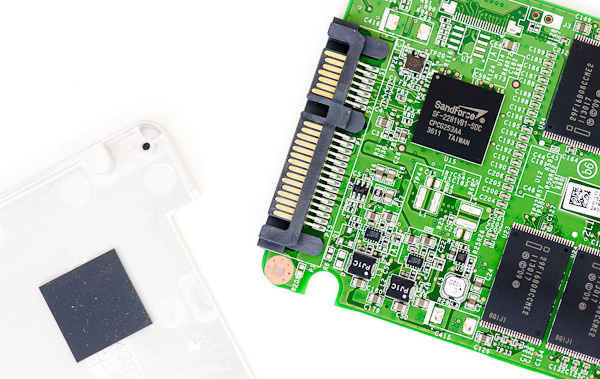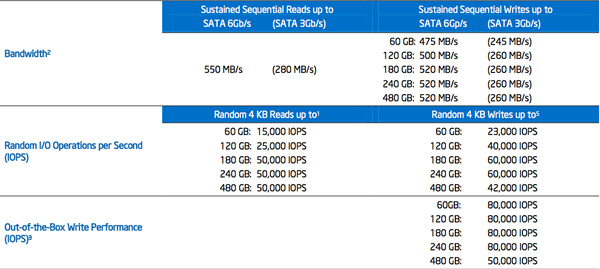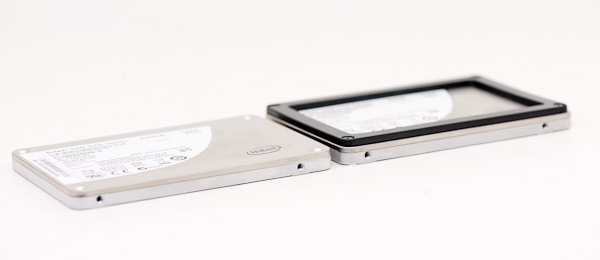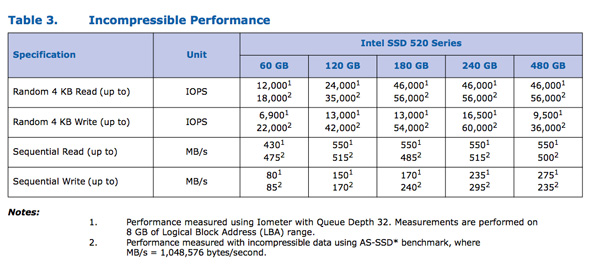Intel SSD 520 Review: Cherryville Brings Reliability to SandForce
by Anand Lal Shimpi on February 6, 2012 11:00 AM ESTThe Intel SSD 520
Intel sent us a 240GB and 60GB SSD 520 for review, but the performance specs of the entire family are in the table below:
The Intel SSD 520 is available in both 9.5mm and 7mm versions, with the exception of the 480GB flavor that only comes in a 9.5mm chassis. The 520's uses Intel's standard 7mm chassis with a 2.5mm removable plastic adapter that we've seen since the X25-M G2. The plastic adapter allows the drive to fit in bays designed for 9.5mm drives. Note that Intel doesn't ship shorter screws with the 9.5mm drives so you can't just remove the plastic adapter and re-use the existing screws if your system only accepts a 7mm drive.
Inside the drive we see the oh-so-familiar SandForce SF-2281 controller and Intel 25nm MLC NAND. The controller revision appears unchanged from other SF drives we've seen over the past year. The PCB design is unique to the 520, making it and the custom Intel firmware the two noticeable differences between this and other SF-2281 drives.

Intel uses the metal drive chassis as a heatsink for the SF-2281 controller
The SF-2281 Controller
I've explained how the SF-2281 works in the past, but for those of you who aren't familiar with the technology I'll provide a quick recap. Tracking the location of data written to an SSD ends up being one of the most difficult things a controller has to do. There are a number of requirements that must be met. Data can't be written to the same NAND cells too frequently and it should be spread out across as many different NAND die as possible (to improve performance). For large sequential transfers, meeting these (and other) requirements isn't difficult. Problems arise when you've got short bursts of random data that can't be combined. The end result is leaving the drive in a highly fragmented state that is suboptimal for achieving good performance.
You can get around the issue of tracking tons of data by simply not allowing small groups of data to be written. Track data at the block level, always requiring large writes, and your controller has a much easier job. Unfortunately block mapping results in very poor small file random write performance as we've seen in earlier architectures so this approach isn't very useful for anything outside of CF/SD cards for use in cameras.
A controller can rise to the challenge by having large amounts of cache (on-die and externally) to help deal with managing huge NAND mapping tables. Combine tons of fast storage with a fast controller and intelligent firmware and you've got a good chance of building a high performance SSD.

SandForce's solution leverages the work smart not hard philosophy. SF controllers reduce the amount of data that has to be tracked on NAND by compressing any data the host asks to write to the drive. From the host's perspective, the drive wrote everything that was asked of it, but from the SSD's perspective only the simplest representation of the data is stored on the drive. Running real-time compression/de-duplication algorithms in hardware isn't very difficult and the result is great performance for a majority of workloads (you can't really write faster than a controller that doesn't actually write all of the data to NAND). The only limit to SandForce's technology is that any data that can't be compressed (highly random bits or data that's already compressed) isn't written nearly as quickly.
Intel does a great job of spelling out the differences in performance depending on the type of data you write to the SSD 520, but it's something that customers of previous Intel SSDs haven't had to worry about. Most client users stand to benefit from SandForce's technology and it's actually very exciting for a lot of enterprise workloads as well, but you do need to pay attention to what you're going to be doing with the drive before deciding on it.
The Intel SSD Toolbox
The Intel SSD 520 works flawlessly with the latest version of Intel's SSD Toolbox. The toolbox allows you to secure erase the drive from within Windows, and it also allows you to perform firmware updates and pull SMART info from the drive. Unlike other SandForce toolboxes, Intel's software works fine with Intel's RST drivers installed.

The Test
| CPU | Intel Core i7 2600K running at 3.4GHz (Turbo & EIST Disabled) - for AT SB 2011, AS SSD & ATTO |
| Motherboard: | Intel DH67BL Motherboard |
| Chipset: | Intel H67 |
| Chipset Drivers: | Intel 9.1.1.1015 + Intel RST 10.2 |
| Memory: | Corsair Vengeance DDR3-1333 2 x 2GB (7-7-7-20) |
| Video Card: | eVGA GeForce GTX 285 |
| Video Drivers: | NVIDIA ForceWare 190.38 64-bit |
| Desktop Resolution: | 1920 x 1200 |
| OS: | Windows 7 x64 |























138 Comments
View All Comments
ckryan - Tuesday, February 7, 2012 - link
True, but the 520 series isn't the 320 series. Intel has the 510 and 520 series to satisfy the user that desires speed, but the fact is Intel will sell more SATA II than SATA III drives for the next few years.lyeoh - Tuesday, February 7, 2012 - link
Maybe making fast expensive drives and selling them for profit isn't Intel's main goal. Perhaps Intel is trying to push the SSD market to the next step.Nowadays drives are often the biggest performance bottleneck, and so it stops making a big difference whether you buy a top of the line Intel CPU or not, or even buy AMD instead.
But once fast SSDs start becoming more reliable and sell at closer to _commodity_ prices, then Intel can get back to selling powerful CPUs to more people.
A marketplace full of fast expensive SSDs that BSOD and lose data and slow cheap hard drives doesn't help for such a goal.
But helping Sandforce _eventually_ get their act together (Intel aren't doing this for free of course) might do so. They might also be concerned about Samsung.
NitroWare - Wednesday, February 8, 2012 - link
"Perhaps Intel is trying to push the SSD market to the next step."Intel has frequently done this with different technologies.So it is logical.
In the article, Intel claimed they had 100% of staff on Intel SSD. Vendors usually do not make claims about internal employee hardware.
Ethernet, Wifi, PCI, Legacy free, non x86 ISA (Xscale, Itanic), Fibre, PC I/O and RAM Technologies.
They even dabbled with video conferencing years ago
gramboh - Monday, February 6, 2012 - link
I'm in the market for a 240gb SSD in the next few months, and would love to buy a 520 series over other SF-2281/Marvell options, but right now it's a 42% price premium which is way too much.The 120gb has a more realistic price premium of about 25% (taking into account rebates on the 2281/Marvell drives) which I would consider, would have been nice for Intel to price the 240gb at $400-430.
mckirkus - Wednesday, February 29, 2012 - link
"Would have been nice for Intel to price the 240gb at $400-430"The 240gb version is $357 on Amazon right now (2/29).
LeftSide - Monday, February 6, 2012 - link
I bought the Kingston version on Black Friday for $120 after MIR. It was a great deal. Although I did worry about the BSOD (especially right after sending in the MIR). Thankfully, I haven't had any problems and it has been an excellent drive. It's unbelievably fast.NitroWare - Wednesday, February 8, 2012 - link
They have the 332 firmware available for download from their website. There is even a toolbox utility now but this only has SMART features and no wipe tool.jaydee - Monday, February 6, 2012 - link
Would you expect the 120GB version to perform similar to the 60GB or the 240GB version? Or right down the middle?extide - Monday, February 6, 2012 - link
Historically, 128GB drives have seemed to perform closer to the 240/256GB counterparts than the 60/64GB ones. That's just my observation, though.ckryan - Monday, February 6, 2012 - link
It's closer to the 240GB in performance. The 60GB SF drives are really at a disadvantage, especially in sequential writes. There have been benches of the 120GB 520 for some time, but the 240GB is unquestionable faster. You might not notice the difference in real usage. You can look at Anand's 120GB roundup from last year, and the 120GB version should come out slightly ahead of the Vertex 3.